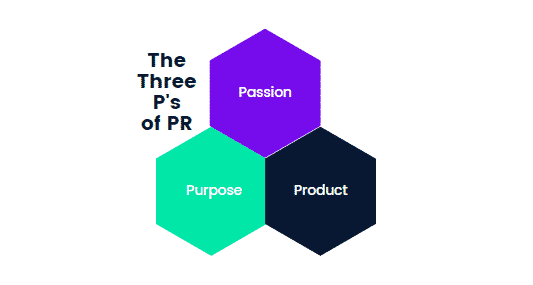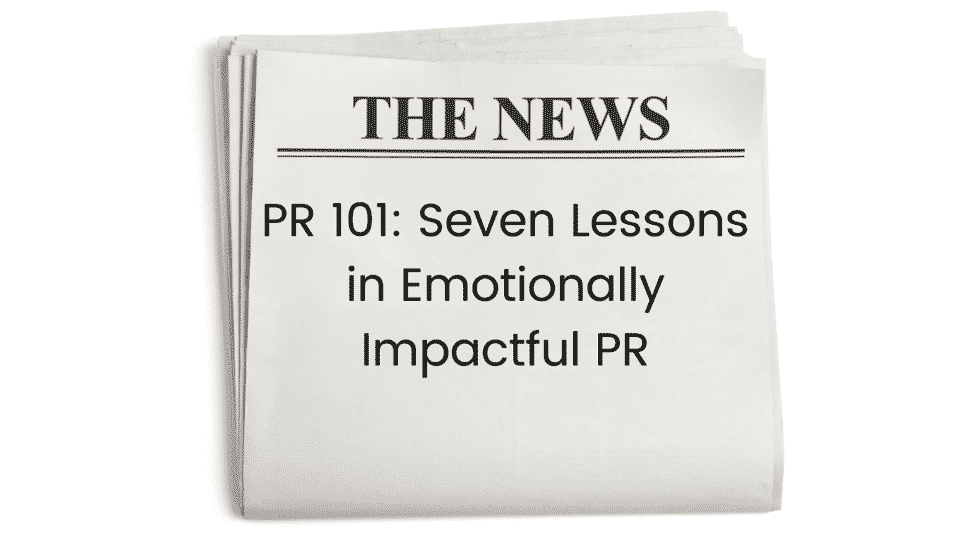For many businesses, the idea of public relations begins and ends with getting coverage in a major news publication. And while getting a mention in The Daily Telegraph is no mean feat, there’s actually a lot more elements that go into a strong and impactful PR campaign – some of which we covered in our previous blog.
In this piece though, we’ll be exploring exactly what businesses need to do to make the most of a PR campaign by utilising emotional intelligence.
Background
If your company (whether an established business or start-up looking to invest in marketing) has finely-tuned a great product or service that customers come back to time after time, you’ve put yourself in a great position to benefit from PR exposure.
Apart from the added publicity that comes from featuring in media publications, you can bank some serious credibility too! Many folks place a huge amount of stock in the stories that appear in reputable publications, and as the person behind the brand, you’ll gain great authority within your sector if you’re appearing in a national newspaper or industry magazine, for instance.
However, the old saying “all publicity is good publicity” rarely holds true these days, and although this piece is aimed at relative newbies looking to scale up marketing efforts, if you do not have a solid grounding on how your business will proceed, it’s best to hold back on looking for any press attention until you do.
Lesson #1: The Three P’s

Any media story that captures the imagination is grounded in three core elements: product, purpose, and passion. Utilising this framework when looking for a story to tell gives you a good understanding of what journalists, and your potential customers will be looking for.
Even if you’re working alongside a PR specialist, which is recommended as a relative newcomer to PR, it’s still essential to use these three points when looking to feed ideas to your partners.
Digging further into the details of the three p’s means you should:
- Product – classify precisely what problems your product or services looks to solve, what it does and what niche it might slide into. By doing this you can begin to highlight publications you can look to contact.
- Purpose – understand that, although your company exists because of your core audience, there’s no need to be in a permanent state of selling. Sure, there will be times when promotion is your sole intention, but in large doses, this is tedious and off-putting, so look for opportunities to talk about your sector without explicitly selling something. Podcasts, thought pieces and local coverage are often great opportunities for this.
- Passion – always communicate with fervent, authentic tones that truly encapsulate your passion, vision and culture of your business. Whatever medium you’re working in, if you’re not offering a human and relatable story, it’s easy to spot. Remember, sincerity, compassion and vulnerability go a long way these days.
Once you have a deep understanding of these concepts, you’re ready to communicate to those outside of your business in a deep and meaningful way, no matter whether you’re appearing on a business podcast or doing an interview for the local press.
Lesson #2: Public vs Human Interest
Both of these ideas revolve around building rapport with an audience – which is the very foundation of what PR is all about. However, when you look at these two concepts more closely, you’ll notice that the goal for each of them is entirely different.
Those looking to tap into public interest are concerned about image and polish, and sure, that’s great in principle, but it really flies in the face of what we talked about in lesson one, doesn’t it?
If you train yourself or your PR partners in the art of human interest, what you’ll find is that you stand a better chance of creating meaningful, social partnerships that provide value and create relationships that stand the test of time.
Lesson #3: Friends Make Better Allies
The very idea of understanding emotional intelligence in your PR efforts, and in fact within your business in general, is that there is considerable value in building and maintaining relationships.
The same applies to your PR strategies themselves, which should be built on your relationships with friends, not just a list of email addresses.
Look at it this way: think about all those unwanted sales emails you get, do you read most of them?
Of course, you don’t.
Consider that a journalist receives dozens of pitch emails every single day, and when something isn’t relevant for them, they simply ignore it. This means, if you don’t put your pitch together in such a way that ticks the human-interest box, then it just smacks of someone looking for “public interest” coverage.
Sending out cold emails to all and sundry will leave no lasting impression on any journalist. In fact, it suggests that all you want is press coverage without caring much how it is delivered. You need people to truly believe that you care about what you’re talking about and this will come across to the journalist and those reading the story.
Time is a precious commodity, and no one understands this better than a journalist on a deadline. So, instead of sending out blanket emails, why not focus your efforts on pitching to fewer journalists, in a more relevant way?
Being a success in any walk of life means that you must invest in others, so the key pointer here is to remember that you’re not just building a database of emails; you are trying to connect to the human being on the other side of the computer screen.
Lesson #4: Building Relationships

The beginning of any relationship is about taking small steps and learning as you go. Of course, this takes time.
Naturally, in business, the temptation to run everywhere at a hundred miles an hour is often overwhelming, but when it comes to making journo buddies, it’s baby steps all the way.
These steps could be something as simple as following them on Twitter, commenting on their articles or liking a post on LinkedIn. Whatever you decide to do, it’s really about making yourself known without coming crashing through the walls shouting at the top of your lungs about your latest press release.
Once you’re on their radar, send a warm intro email. Of course, it’s probably a good bet that you already understand what it is that you’d like to gain from forging a relationship with this person, but now is not the time to ask for it.
Your introduction should be friendly in tone; telling the recipient who you are and what you do, all the while reinforcing why a relationship between the two parties could be of mutual benefit down the line.
Although the PR game may seem like the selfish pursuit of attention; real PR is actually quite the opposite. Once you’re able to go to a journalist in the right way, it becomes about what you can offer them, which means the relationship becomes a two-way street of mutual benefit.
Lesson #5: Coverage Isn’t One and Done
When you’re building up your rapport with journalists, it’s important to bear in mind that attaining coverage in the media isn’t a one and done process.
The real key to PR success comes down to your businesses ability to solve a universally acknowledged problem for your audience. If you’ve laid the groundwork to ensure this happens then any story you’re putting out in the media is far more likely to have the legs to last.
On the flip side, if you’re trying to use PR to paper over the cracks of a half-thought-out idea or poor product, you’ll be found out very quickly.
So often our egos are tightly wound to our business, so much so that when we find it may not have been the solution we hoped it to be, we’re massively shaken by it.
But remember that if your stories aren’t gaining the traction you hoped, it may not be you, the product or the service, it may simply be that you’ve not thought about the angle of the story (we’ll cover this more in lesson seven).
Every journalist has seen your story in various guises a million times before, so it’s important to ensure that your process and story angles are constantly evolving.
If it’s not working, take time out to really evaluate why.
Lesson #6: Play the Long Game

Contrary to what you might believe, getting coverage in The Telegraph isn’t a measure of your success. Coverage in the media is but a drop in the ocean – particularly in this day and age.
It’s already old news from the moment the editor clicks publish. Think of it this way: you’ve just bought a shiny new car, but the very moment you pull away from the forecourt that car’s value has diminished.
This is why it’s so important to sit back and try to envision how the long game will play out – short-term thinking has no place in the PR world.
Any business strategy is always subject to change, and your thoughts and feelings about where your business should be heading will always evolve. After all, isn’t owning a business very much dependent on your ability to absorb knowledge and pivot accordingly?
Of course, there will be some internally or externally that will be resistant to these changes, and may no longer see the value of what you’re trying to achieve. And that’s okay – that’s just life.
This is when your hard work in cultivating friendly relationships comes around full circle. It’s these folks that will back your decisions and requirements to change course – every captain needs a first mate, right?
You’ll rally this support because you’ve taken the time to show them the whole canvas rather than just a single stroke of the paintbrush, and therefore they can see why you’ve chosen your direction and what benefit they might gain in the long-term.
Lesson #7: Learn When to Let Go
There’s a fine line between checking in on the progress of your story and just being plain annoying. As we’ve already covered sometimes your story just isn’t right for a publication, your timing is off or it’s just plain not interesting – sorry!
But, this is where those connections you’ve built with writers can really pay dividends. Sure, the story isn’t what those connections are looking for right now, but who’s to say it won’t be six or eight or twelve months down the line?
If you’ve put time into building these relationships with writers, they should have no trouble telling you that your story isn’t interesting, where it could be improved or when there may be a better time to pitch it.
Either way, there’s no need to keep badgering them, sometimes it’s just a case of taking things back to the drawing board and learning to let go, no matter how much you might believe in what you’re doing.
Takeaways
When all’s said and done, we’re all just human beings with thoughts and feelings, sometimes it’s easy to forget that.
In business, you do what you can to learn and grow. Therefore it’s so important to realign our focus towards building relationships with each other; one-sided business relationships are a thing of the past, and if you aren’t able to shake this habit your PR efforts will suffer.
So, ditch the Google Sheets full of hundreds of email addresses, and begin homing in on creating relationships with select media professionals to help create an environment built on mutual trust and benefit.
Now, more than ever is the time to really understand that human interest is at the very heart of PR.
If you have any questions about our PR approach or would like to know more about any of our other services, please get in touch with our team of experts.

